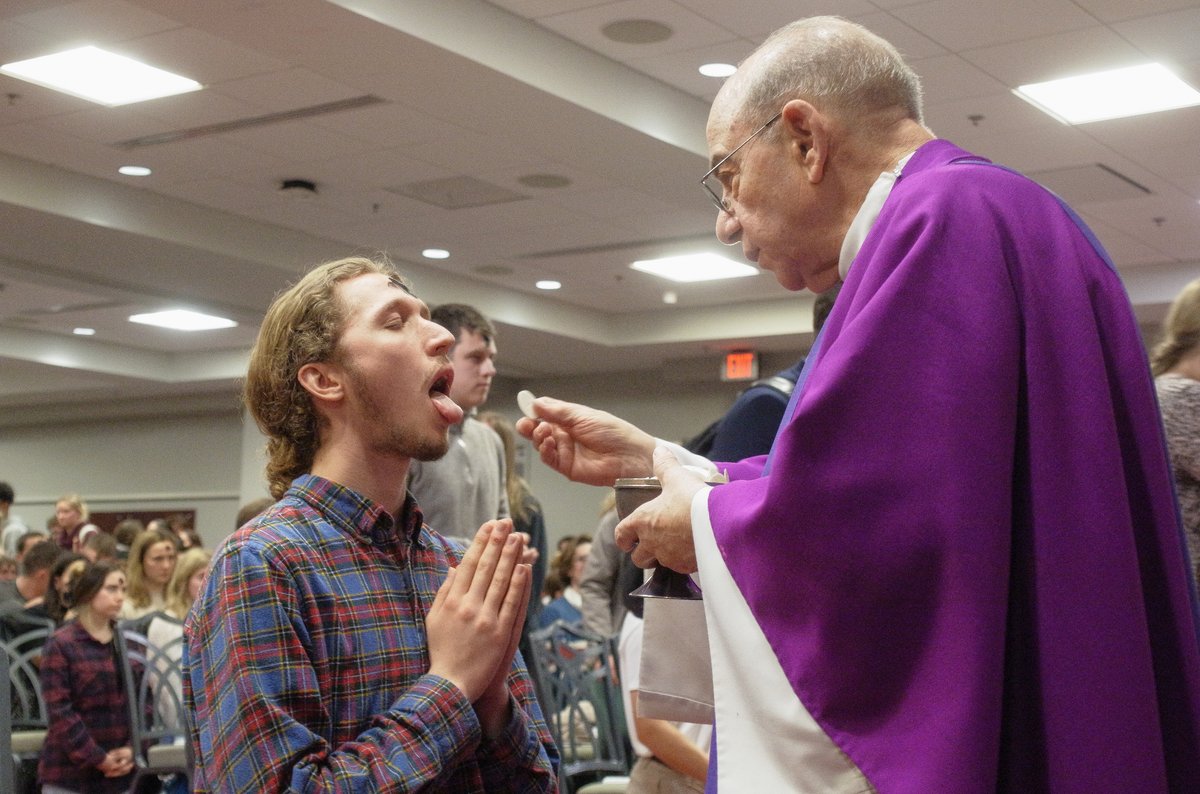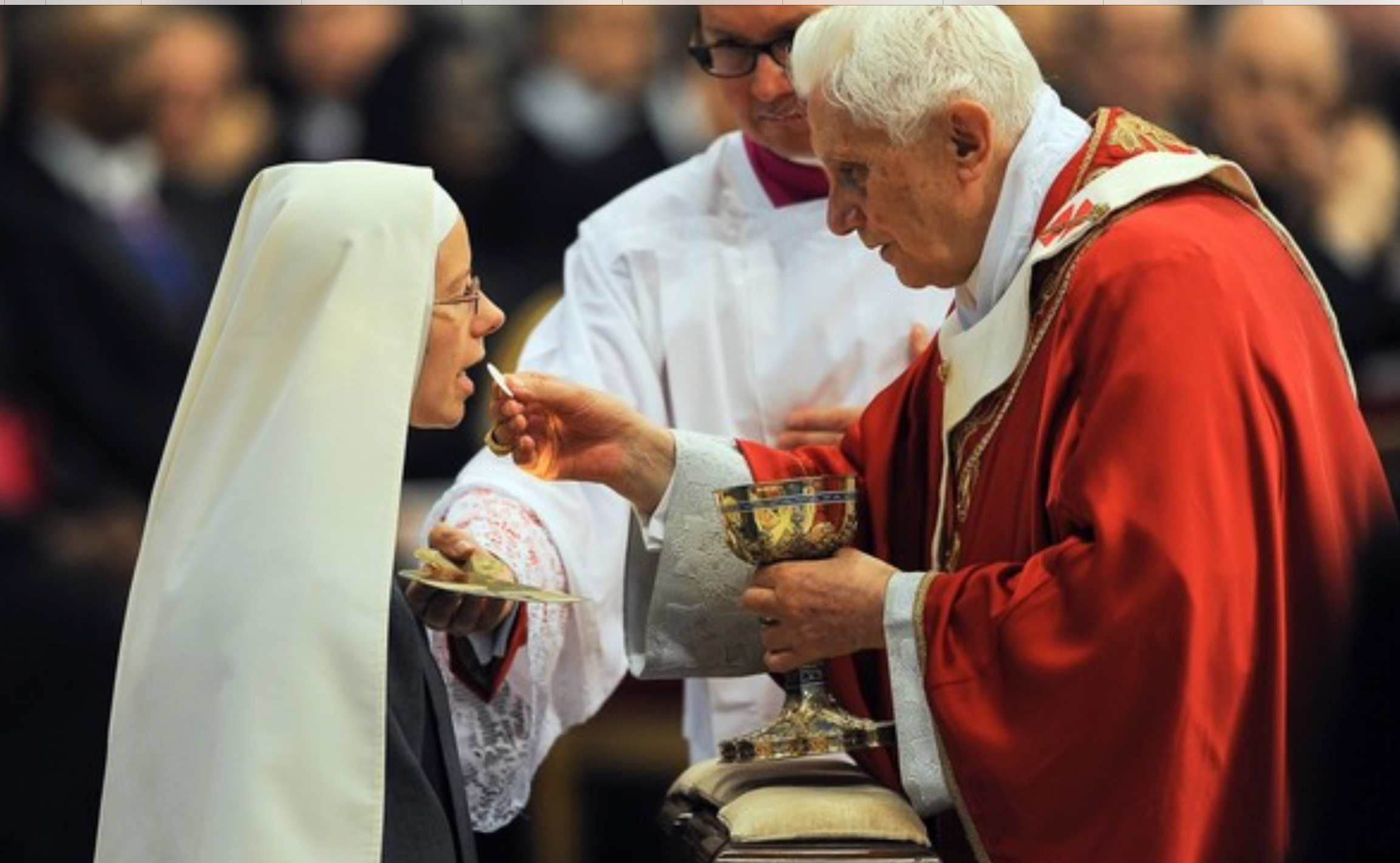Today, on this solemnity of Corpus Christi, let’s focus on this phrase in the Gospel: “All ate and were filled. What was left over was gathered up, twelve baskets of broken pieces” (Lk 9:17). The scene is the multiplication of loaves. Jesus feeds the 5,000-plus crowd spiritually with His word, then physically by miraculously multiplying bread and fish. (Please watch 1:19 – 4:10.)
The scene ends with the phrase: ‘What was left over was gathered up, twelve baskets of broken pieces.’ Why is this detail recorded?
The first reason is because it shows Jesus providing more than the people need, so much so that there were leftovers. Have you ever had the experience when someone who loves you over delivered? It was your birthday and your family surprised you with a gift that exceeded your expectations? You were sick and someone bent over backwards to take care of you? This is Who Jesus is: He gives more than we expect.
The deeper reason this detail is recorded is because it has to do with the crumbs of the Eucharist when we receive Holy Communion. In St. John’s Gospel, Jesus gives a command, “Gather up the fragments left over, so that nothing may be lost” (6:12). He doesn’t want anything lost because that bread foreshadows His Eucharistic Body.
Have you ever seen the Eucharist fall to the ground? It’s hurtful to see the Eucharist treated casually. Ever felt crumbs on your palms? I recently concelebrated Mass with another priest and noticed that, because we were away from the altar, he discreetly checked his fingers for particles. Deacon Andrew does the same thing when purifying the sacred vessels: If there are distinct pieces of Communion left, he uses his finger to consume them. I’ve also noticed one person here who always checks her palms after receiving—inspiring. Here’s a video from 2015 of the future Polish president rescuing the Eucharist:
Notice the instinctive and beautiful gesture of protecting the Eucharist with one hand on top!
Every year on Corpus Christi, we thank Jesus for the gift of His Body and review how we receive Communion. Today, we have a specific goal: That no fragments of the Eucharist fall to the ground.
In the Gospel, there are two clear connections to the Eucharist: 1) “On their return the apostles told Jesus all they had done. He took them with him and withdrew privately to a city called Bethsaida. When the crowds found out about it, they followed him; and he welcomed them, and spoke to them about the kingdom of God, and healed those who needed to be cured” (Lk 9:10-11). Jesus and the apostles need to rest, but the people are searching for truth and healing, and so Jesus gives of Himself, because He’s God, Who is love. Love always gives itself to the beloved, which is what Jesus does in the Eucharist. 2) “And taking the five loaves and the two fish, he looked up to heaven, and blessed and broke them, and gave them to the disciples to set before the crowd” (9:16). Scripture scholars recognize the four verbs, ‘take,’ ‘bless,’ ‘break,’ and ‘give’ are technical verbs for the Eucharist. They’re used again at the Last Supper and when Jesus reveals Himself on the road to Emmaus.
Beyond these two connections, the Mass echoes the multiplication of the loaves in four ways: 1) Jesus first feeds with His word then His Body, just as we have the Liturgy of the Word then of the Eucharist; 2) when Jesus says to the apostles, “You give them something to eat” (9:13), this resembles priests feeding people with the Eucharist; 3) Jesus asks that the crowd “sit down in groups of about fifty each” (9:14), just as, during the time this Gospel was written, the early Christians were gathering in houses for Mass with around 50 people; 4) in Eucharistic Prayer I, the priest looks up to heaven the way Jesus ‘looked up to heaven’ while blessing the bread.
Now let’s get into the practicalities of receiving Communion. I always suggest receiving on the tongue, not because it’s holier, but because of its unique sign value in our culture: Since we don’t receive regular food like this, it’s a sign that the Eucharist is special. However, one tip: Please do not tilt your head way back and stick your tongue far out—you know what traditional priests say about this? Stop doing it! The Eucharist doesn’t adhere well to our tongue this way.
Just look straight forward, hold still, and let the priest or deacon place the Eucharist on your tongue.
As for receiving on the hand, one hand should be placed underneath the other, and we should protect the Eucharist or fragments from falling, with one hand guiding the Eucharist to our mouths. Here is a video showing five ways we should not receive Communion, and a proper way:
For priests, the General Instruction of the Roman Missal says, “Whenever a fragment of the host adheres to his fingers, especially after the fraction or the Communion of the faithful, the priest is to wipe his fingers over the paten or, if necessary, wash them” (278). Similarly, we should make sure that there are no fragments of the host on our hands; if there are, we consume them because we never want them to fall to the ground.
But the most important part is that we believe the Eucharist to be the Body of Christ and love Him. Following up from what we said in December, it’s so important to know that Jesus wants us to receive Him. This is a message to those of us who rarely take Communion—it’s clear that we love Jesus. Not taking Communion is better than taking Communion in a state of mortal sin. Most of us know that we should never take Communion in a state of mortal sin, for example, if we miss Sunday Mass through our own fault, then we can’t take Communion until we go to Confession. And we know that we must be baptized Catholic before we receive Communion. That said, Jesus wants us to be in a state of grace and it gives Him joy when we receive Him.
Imagine if our best friend in the world were to come to our house—who is that person? Besides God, who is the person you love most? If he or she were to come to our house and ask to come in, but we say, for whatever reason, that they can’t, then they wouldn’t be angry, but would ask, ‘Is there anything we can do to fix the situation?’ In the same way, Jesus wants to enter our body and soul, but, for some reason, we say, ‘I’m not yet ready, Jesus.’ He’s not angry, but wants to fix the situation with us. He wants to give Himself to us and us to get ready to receive Him.
As mentioned, we hope that 2026 will be a year of preparation for Eucharistic adoration, where we consider if we’d commit to spending one hour a week with Jesus in the chapel. We’re already looking to invite three speakers to help us get ready.
Let’s finish with a video about a Eucharistic miracle. When it talks about the Eucharist being placed in water after falling to the ground, that’s one reverent way of naturally letting the Eucharist lose its properties of bread.
The Holy See is extremely reticent about declaring anything a miracle because we search for truth and many miracles can’t be proven. But, in this case, if Jesus has given us a miracle, it’s to remind us that He wants to give us Himself, His heart, and that He is truly present in the Eucharist, which is why we want nothing to be lost.


